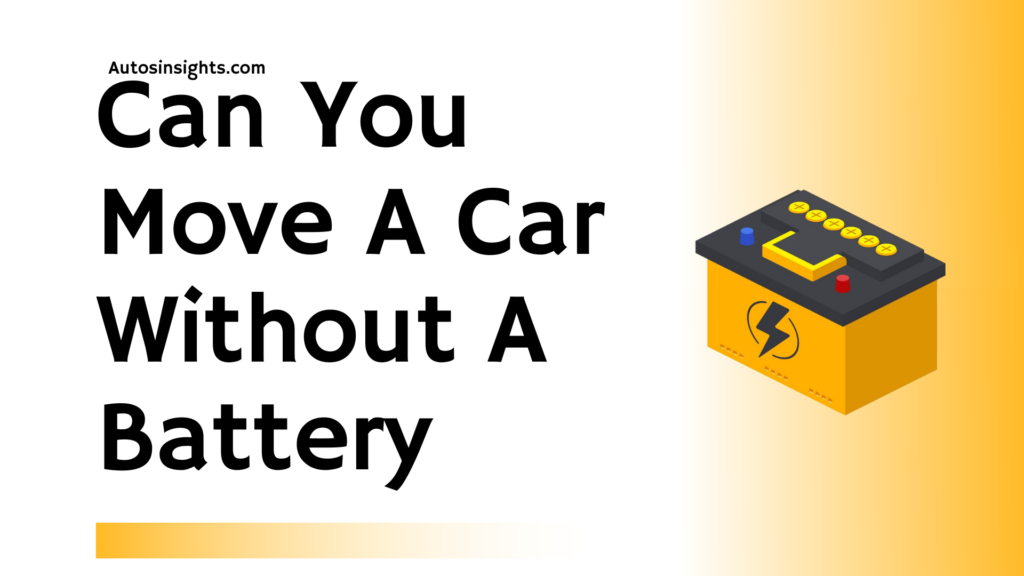Have you ever found yourself in a situation where your car’s battery has died and you need to move the car. It can be frustrating, especially if you’re in a hurry or if it’s an inconvenient location. But can you move a car without a battery.
Can you move a car without a battery
The short answer is yes, it is possible to move a car without a battery, but it’s not always easy and it depends on the specific situation.

Here are a few ways this can be done:
- Push start the car: Some cars have a push-start feature that allows them to be started without the use of a key or a battery. To do this, you will need to push the car to get it moving and then press the brake pedal while turning the ignition switch to the “on” position. If the car has a push-start feature, it should start.
- Use a jump-start: If the car has a dead battery but the engine is in good working order, you can try jump-starting the car using another vehicle or a portable jump-starter. To do this, you will need to connect the jump-starter to the dead car’s battery using the appropriate cables and then start the jump-starter. This should provide enough power to start the car.
- Use a tow truck: If the car is unable to start due to a dead battery and you do not have a jump-starter or another vehicle to use, you can call a tow truck to take the car to a mechanic or a garage where it can be repaired.
It is important to note that attempting to move a car without a battery can be dangerous, especially if the car is on a roadway.
Guide about how you can move a car without a battery
Moving a car without a battery refers to the act of starting and operating a vehicle without the use of its battery.
This may be necessary in situations where the battery is dead or not functioning properly, or if a person wants to try and jumpstart the car without using cables.
It can also be useful for those who want to learn more about how a car works and how to troubleshoot issues with it.
How to move a car without a battery
- Steps for pushing a car to start it
- Tips for safely moving a car without a battery
To move a car without a battery, the first step is to find a flat surface to work on and make sure the car is in neutral.
Next, have someone push the car while you hold the key in the ignition and try to start it. If the car starts, you can drive it to a safe location or try to jumpstart it with a working battery.
It is important to be careful when pushing a car, as it can be dangerous if the car starts moving too quickly or if someone falls in front of it.
Alternatives to moving a car without a battery
- Using a jump starter
- Using a tow truck
If you are unable to move your car without a battery or do not feel comfortable trying to push it, there are several alternatives to consider. One option is to use a jump starter, which is a portable device that can provide a boost of power to your car’s battery.
To use a jump starter, you simply need to connect the device to your car’s battery and turn it on. Another option is to call a tow truck and have your car taken to a mechanic or service center.
This may be the best option if you are not comfortable working on your car or if you do not have the necessary tools or equipment.
Tips for maintaining your car’s battery
- Keeping the battery clean and dry
- Regularly checking the battery’s water level
- Avoiding leaving the car idle for long periods of time
To avoid the need to move your car without a battery, it is important to take good care of your car’s battery.
This includes keeping it clean and dry, as dirt and moisture can cause battery corrosion and reduce its lifespan. You should also regularly check the battery’s water level and top it off with distilled water if needed.
Additionally, it is a good idea to avoid leaving your car idle for long periods of time, as this can cause the battery to drain.
Signs that your car’s battery may be failing
- Difficulty starting the car
- Flickering headlights
- Weak or dim interior lights
- Slow cranking sound when starting the car
There are several signs that your car’s battery may be failing and in need of replacement. One common sign is difficulty starting the car, which may indicate that the battery is unable to provide enough power to the starter.
Flickering headlights or weak or dim interior lights can also be a sign that the battery is not functioning properly. Additionally, if you hear a slow cranking sound when starting the car, this may indicate that the battery is struggling to provide enough power.
How to diagnose a failing car battery
- Using a multimeter to test the battery’s voltage
- Checking the battery’s age
- Checking the alternator and starter
To diagnose a failing car battery, one of the first steps is to use a multimeter to test the battery’s voltage. If the battery is fully charged, it should read between 12.6 and 13 volts.
If the voltage is lower than this, it may indicate that the battery is failing or has already failed. You should also check the age of the battery, as most batteries only last for about 3-5 years. If the battery is older than this, it may be time to replace it.
Additionally, you should check the alternator and starter to make sure they are functioning properly, as these components can also affect the battery’s performance.
How to choose a new car battery
- Considering the battery’s size and type
- Checking the battery’s warranty
- Reading reviews and comparing prices
When it comes to choosing a new car battery, there are several factors to consider. One important factor is the size and type of the battery, as it must be compatible with your car’s specifications.
You should also check the battery’s warranty and make sure it offers a good level of protection. It can also be helpful to read reviews and compare prices from different retailers to find the best value.
How to install a new car battery
- Preparing the necessary tools and equipment
- Disconnecting the old battery
- Installing the new battery
Installing a new car battery is a relatively simple process, but it is important to follow the proper steps to ensure a successful installation. First, gather the necessary tools and equipment, including a socket wrench, pliers, and a wire brush.
Next, locate the old battery and use the socket wrench to loosen and remove the negative and positive terminals. Be sure to disconnect the negative terminal first to avoid any accidents. Once the old battery is removed, carefully install the new battery, making sure to connect the positive terminal first and then the negative terminal.
Tips for maintaining your car’s battery after installation
- Keeping the battery clean and dry
- Regularly checking the battery’s water level
- Avoiding leaving the car idle for long periods of time
- Avoiding extreme temperatures
To make sure that your car’s new battery lasts for as long as possible, it is important to follow some basic maintenance practices.
This includes keeping the battery clean and dry, regularly checking the water level and topping it off with distilled water if needed, and avoiding leaving the car idle for long periods of time.
You should also avoid exposing the battery to extreme temperatures, as this can cause it to degrade more quickly.
How to jumpstart a car with a dead battery
- Gathering the necessary tools and equipment
- Connecting the jumper cables
- Starting the donor car
- Starting the car with the dead battery
Jumpstarting a car with a dead battery is a simple process that can be done with a few basic tools and a working battery from another car.
Next, locate the battery in both cars and use the socket wrench to loosen and remove the negative and positive terminals.
Then, connect the jumper cables to the appropriate terminals, making sure to follow the correct order: first, connect the positive terminal of the donor battery to the positive terminal of the dead battery, and then connect the negative terminal of the donor battery to a metal ground on the car with the dead battery.
Finally, start the donor car and let it run for a few minutes, and then try to start the car with the dead battery.
Tips for jumpstarting a car safely
- Making sure the jumper cables are in good condition
- Ensuring that both cars are in a safe location
- Avoiding touching the jumper cables together
- Disconnecting the jumper cables in the correct order
To jumpstart a car safely, it is important to follow some basic precautions. First, make sure the jumper cables are in good condition and free of any frays or breaks. Next, make sure that both cars are in a safe location, away from traffic and any other hazards. It is also important to avoid touching the jumper cables together, as this can create a dangerous spark.
When disconnecting the jumper cables, make sure to do so in the correct order: first, disconnect the negative terminal of the donor battery, and then the positive terminal. Finally, remove the jumper cables from the car with the dead battery in the same order.
When to use a jump starter instead of jumper cables
- Convenience and portability
- Safety concerns
- Limited access to another car
In some cases, it may be more convenient or safer to use a jump starter instead of jumper cables to start a car with a dead battery.
Jump starters are portable devices that can provide a boost of power to a dead battery, and they do not require another car to provide the power.
This can be especially useful if you are stranded in a remote location or do not have access to another car. Jump starters are also generally safer to use than jumper cables, as they do not require any physical connection to the car’s battery and do not pose the risk of creating a spark.
How to use a jump starter
- Gather the necessary tools and equipment
- Connect the jump starter to the car’s battery
- Turn on the jump starter
- Start the car
Using a jump starter is a relatively simple process that can be done with just a few basic tools and equipment.
To begin, gather the jump starter, a socket wrench, and a wire brush. Locate the car’s battery and use the socket wrench to loosen and remove the negative and positive terminals.
Then, connect the jump starter to the battery according to the manufacturer’s instructions, making sure to follow the correct order.
Once the jump starter is connected, turn it on and wait a few minutes for it to charge the battery. Finally, try to start the car and see if it starts.
Tips for using a jump starter safely
- Reading and following the manufacturer’s instructions
- Make sure that the jump starter is charged and in good working condition
- Avoiding using the jump starter in extreme temperatures
- Disconnecting the jump starter in the correct order
To use a jump starter safely, it is important to read and follow the manufacturer’s instructions carefully. Make sure the jump starter is charged and in good working condition before using it.
Avoid using the jump starter in extreme temperatures, as this can affect its performance and increase the risk of accidents.
When disconnecting the jump starter, make sure to do so in the correct order, following the instructions provided by the manufacturer. This will help ensure that you do not accidentally create a spark or damage the car’s battery.
How to jumpstart a car with a manual transmission
- Putting the car in neutral
- Starting the donor car
- Pushing the car with the dead battery
- Starting the car with the dead battery
Jumpstarting a car with a manual transmission can be slightly different than jumpstarting a car with an automatic transmission.
To begin, put the car with the dead battery in neutral and engage the parking brake. Next, start the donor car and let it run for a few minutes.
Then, have someone push the car with the dead battery while you hold the key in the ignition and try to start it. If the car starts, you can drive it to a safe location or try to jumpstart it with a working battery.
How to jumpstart a car with a hybrid battery
- Gathering the necessary tools and equipment
- Disconnecting the hybrid battery
- Jumpstarting the car with the internal combustion engine
- Reconnecting the hybrid battery
Jumpstarting a car with a hybrid battery can be slightly more complicated than jumpstarting a traditional car with a single battery.
To begin, gather the necessary tools and equipment, including jumper cables, a socket wrench, and a wire brush. Next, locate the hybrid battery and use the socket wrench to loosen and remove the negative and positive terminals.
Be sure to disconnect the negative terminal first to avoid any accidents. Once the hybrid battery is disconnected, you can jumpstart the car with the internal combustion engine using the same process as a traditional car.
When you are finished, be sure to reconnect the hybrid battery according to the manufacturer’s instructions.
How to jumpstart a car with a damaged battery terminal
- Cleaning the damaged terminal
- Using a terminal repair kit
- Jumpstarting the car
If the battery terminal on your car is damaged, it may be difficult to jumpstart the car using traditional methods. To begin, clean the damaged terminal with a wire brush to remove any dirt or corrosion.
Next, consider using a terminal repair kit to fix the damage and make it easier to connect jumper cables or a jump starter. Once the terminal is repaired, you can proceed with jumpstarting the car as usual.
How to jumpstart a car with a discharged battery
- Recharging the battery
- Jumpstarting the car
If the battery in your car is completely discharged, it may not be possible to jumpstart the car using traditional methods.
In this case, you will need to recharge the battery before attempting to jumpstart the car. There are several ways to recharge a battery, including using a battery charger or jump starter.
Once the battery is charged, you can proceed with jumpstarting the car as usual.
Mistakes to avoid when jumpstarting a car
- Connecting the jumper cables in the wrong order
- Using damaged or frayed jumper cables
- Allowing the jumper cables to touch each other
- Disconnecting the jumper cables in the wrong order
There are several common mistakes that people make when jumpstarting a car, which can lead to accidents or damage to the car.
One mistake is connecting the jumper cables in the wrong order, which can create a dangerous spark or damage the car’s electrical system. Another mistake is using damaged or frayed jumper cables, which can also create a spark or fail to provide a proper connection.
It is also important to avoid allowing the jumper cables to touch each other, as this can create a spark or cause an electrical short. Finally, be sure to disconnect the jumper cables in the correct order, following the instructions provided by the manufacturer.
Pros and cons of moving a car without a battery
- Advantages of this method
- Disadvantages of this method
There are several pros and cons to consider when it comes to moving a car without a battery. One of the main advantages is that it can be a quick and easy solution if you are stranded on the side of the road with a dead battery.
It can also be a good way to test the condition of your car’s starter and ignition system if you are experiencing starting issues.
However, there are also several downsides to this method. It requires physical effort and can be tiring, especially if you are pushing a heavy car. It can also be dangerous if the car starts moving too quickly or if someone falls in front of it.
Conclusion
Moving a car without a battery is possible in certain situations, but it requires physical effort and can be dangerous if not done correctly. Jumpstarting a car with a dead battery is a safer and more convenient option, and it can be done with jumper cables or a jump starter.
To ensure the safety and success of this process, it is important to follow the proper steps and precautions, such as using good quality jumper cables, making sure both cars are in a safe location, and following the manufacturer’s instructions.
Additionally, to avoid the need to jumpstart your car, it is important to take good care of your car’s battery by keeping it clean, checking the water level, and avoiding leaving the car idle for long periods of time.
Related Articles:
- Can You Touch a Positive Terminal Of A Car Battery
- Can 5 Watt Solar Panel Charge A Car Battery
- How To Clean Car Battery Corrosion
- How Long Does It Take To Change A Car Battery
- Does Driving Charge Your Car battery
- Car Battery Doesn’t Fit In A Tray
- How To Drain Car Battery
- Car Battery Dies After Getting Gas
- Can A Bad Battery Cause Low Voltage




